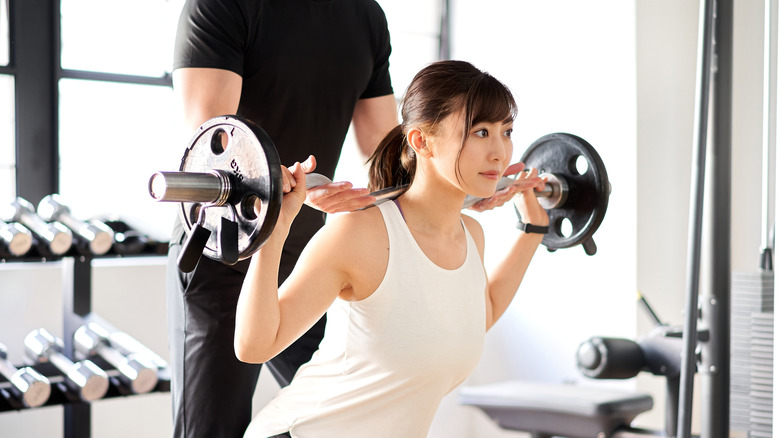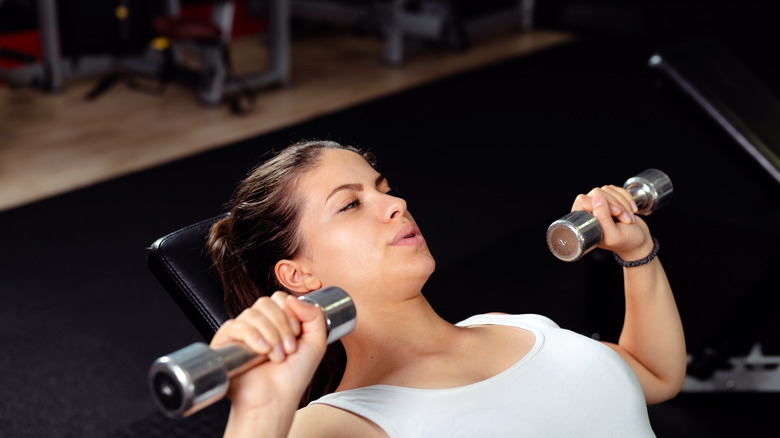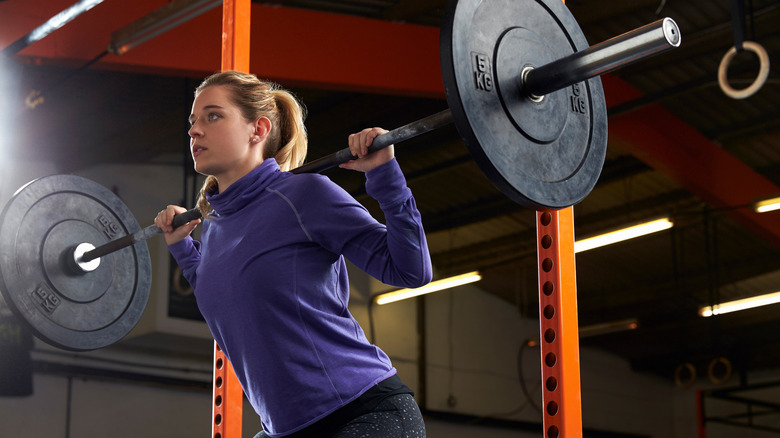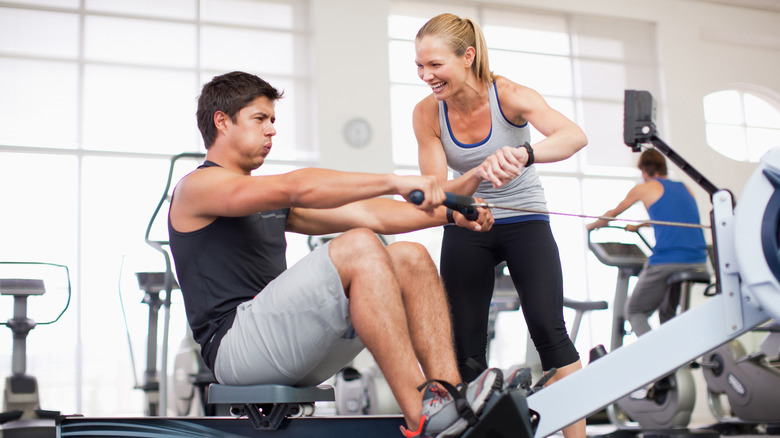If Weight-Lifting Workouts Seem Intimidating, Our Tips Will Help You Get Started
Starting a fitness journey can be intimidating if you're unsure where to begin. It's a huge step to get that gym membership, but what do you do after that? Many new members may stick to what feels safe and familiar, such as the treadmill, but there are many machines to take advantage of that offer multiple benefits. However, if you've been a member for a while but tend to stick with simple exercises, it might be time to grab some weights.
Strength training offers benefits that can help you in the long run. The Mayo Clinic claims strength training can help you do everyday tasks, such as carrying heavy groceries, without struggling. Plus, it helps protect your joints by making them stronger. While weight lifting strengthens your physical body, it can also improve your mental health, lowering depression and anxiety and increasing self-esteem, per Fitness Genes.
There are a few mistakes new lifters make when they first start. According to Piedmont Healthcare, first-time lifters are prone to skip warming up, which can cause injuries if the body is lifting with cold muscles. In addition, poor form when performing an exercise can also cause unwanted injuries, which is why it's vital to master the form before starting any weight lifting. Once you learn the right way to lift, the intimidation will go away. If you're unsure where to start, we gathered a few tips to help you out.
Have a workout plan
Pre-planning the exercises you're going to do on your lifting day instead of figuring it out as you go can make your session run smoothly. According to bloggers He and She Eat Clean, creating a workout plan will prevent burnout. When you have a set workout schedule, you'll accomplish more and see results, whereas if you don't have a plan, you'll waste time figuring out what to do. In addition, following a workout plan ensures that you aren't under-training or overtraining different muscle groups.
When you see results, you get motivated to continue going to the gym and push yourself harder. You might be thinking that if you follow the same workout plan, you'll eventually get bored of it, but that's not true. MyFitnessPal claims that lifters change their routine every four to six weeks. You don't have to change the entire thing; instead, switch up a couple of exercises for ones that target the same muscles but require a different movement. For example, instead of making reverse lunges, do walking lunges. On the other hand, if you like your routine, you can always increase the weight every two to three weeks to get stronger.
Start with body-weight exercises
Before you start weight training, it's critical to begin by working with your body weight while you master the form — this will help prevent injury. According to In Motion O.C., " you use your body weight to provide resistance against gravity." So, you're still getting in a good workout using your body weight, since it already provides resistance. When you later start using heavier weights, you add more resistance. You might wonder, how can you get stronger by using only your body weight? Even though you're not using heavier weights at first, your body will get stronger and you'll increase your endurance when performing the same exercises you would do with weights.
A few body exercises you can start with are squats, push-ups, pull-ups, lunges, and mountain climbers to get your body familiar with the movements. A great way to make the exercises challenging once you feel like you get used to them is increasing the reps and reducing your rest time between each set. Then, once you feel confident with each exercise, you can move on to light weights.
Upgrade to light weights
Your body already offers resistance against gravity when you exercise, so when you add extra weight, you add more resistance. Once you've mastered the form of your body-weight exercises, you can move on to light weights. With light weights, you continue practicing your form while building muscle and preparing for heavier weight. In addition, using light weight is an ideal way to warm up your muscles and guard against injury.
Depending on your goals, you might stick with the same exercises you did when using your body weight, but you can also incorporate new exercises along the way. Using free weights before getting into the machines such as the squat rack or bench press is best. When you start using light weights, you want to be able to do the exercise with the weight for 10 to 12 reps per set. If you can't do at least ten reps every time, you'll want to use less weight, but if you can do more than 12 reps, you can increase the weight.
Slowly move to heavy weights
Once you've progressed enough with light weights and feel stronger, you can move on to free-weight machines. When lifting heavy weights, it's essential to warm up your body and start with a light set, then go into heavier weights. For example, if you want to try out the squat machine, you can do a set of 10 to 12 reps squatting only with the bar to give you an idea of how heavy it is and whether you'll be able to add more weight on the next set. The goal is to do ten reps easily before moving up in weight, especially with free weight machines such as bench press, leg press, and squat rack.
There are assistant machines, like a Smith machine, that can help make carrying the bar easier since it's supported by steel rails that move with you. It's perfect for multiple exercises like squats, bench presses, Romanian deadlifts, and bent-over rows. The Smith machine is handy for beginners, especially if you're nervous about your first few sets.
Find someone knowledgeable
If weightlifting intimidates you, there are always multiple sources you can go to for help. Most gyms offer guidance from personal trainers, so you can book a couple of sessions to understand precisely how to do specific exercises. You'll be able to get one-on-one training and be able to ask questions. They vary in price, but you can ask if they offer free sessions or discounts.
On the other hand, you don't need to invest in a personal trainer; many personal trainers online offer a plethora of tips for free. In addition, some use social media platforms like Instagram or TikTok to spread what they've learned along their journey. However, be mindful of the source: Many fitness influencers aren't certified trainers and don't always have the most informed advice. Knowledgeable personal trainers will have a certification through an organization like NASM, ACE, or ISSA, which signifies that they've taken training courses and learned the ins and outs of exercise science, human movement, and nutrition, among other things.
It's important to remember that even if something works for someone else, it might not necessarily work for you. Figuring out the proper workout routine for yourself can take some time, but using helpful resources can get you on track.





